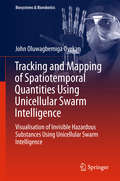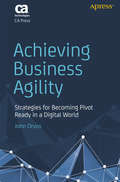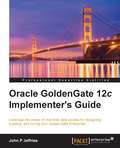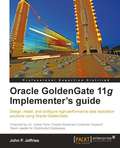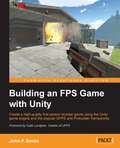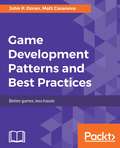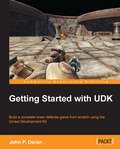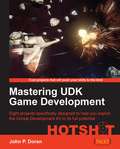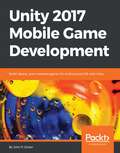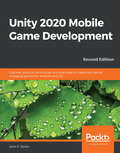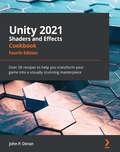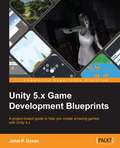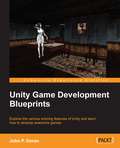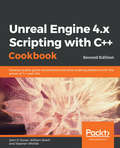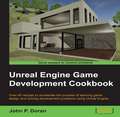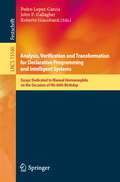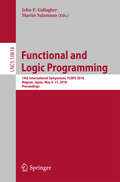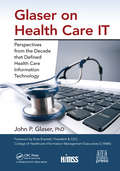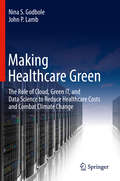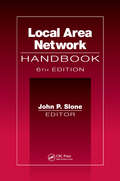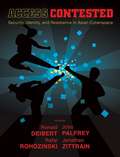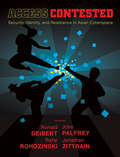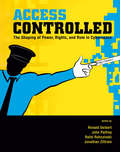- Table View
- List View
Tracking and Mapping of Spatiotemporal Quantities Using Unicellular Swarm Intelligence
by John Oluwagbemiga OyekanThe book discusses new algorithms capable ofsearching for, tracking, mapping and providing a visualization of invisiblesubstances. It reports on the realization of a bacterium-inspired roboticcontroller that can be used by an agent to search for any environmental spatialfunction such as temperature or pollution. Using the parameters of amathematical model, the book shows that it is possible to control theexploration, exploitation and sensitivity of the agent. This feature sets thework apart from the usual method of applying the bacterium behavior to roboticagents. The book also discusses how a computationally tractable multi-agentrobotic controller was developed and used to track as well as provide a visualmap of a spatio-temporal distribution of a substance. On the one hand, thisbook provides biologists and ecologists with a basis to perform simulationsrelated to how individual organisms respond to spatio-temporal factors in theirenvironment as well as predict and analyze the behavior of organisms at apopulation level. On the other hand, it offers robotic engineers practical andfresh insights into the development of computationally tractable algorithms forspatial exploratory and mapping robots. It also allows a more general audienceto gain an understanding of the design of computational intelligence algorithmsfor autonomous physical systems.
Achieving Business Agility: Strategies for Becoming Pivot Ready in a Digital World
by John OrvosKnow how to lead and establish business agility in your organization. Benefit from clear, actionable steps based on change management truths that have been long underutilized and have limited the success of agile expansion into your business. This book provides a pragmatic framework for leading your business toward shifting to an agile mindset. Achieving Business Agility offers strategies and concrete examples to engage business executives and will teach you how to effectively execute these strategies. Whether you are a delivery executive, a change advocate, a consultant, a business leader, or a newcomer to agile, you will learn clear actions from a practical, business-oriented perspective that is vital to effect change and bring agile into your business. The book is structured in three sections. The first provides you with a deep understanding of each of four strategies. The second section tells the story of a company that applied these strategies through the eyes of several key players. The last section helps you get started applying what you learned in your own company. What You’ll Learn Get the attention of your executives by alerting them to a company problem that can impact them personally and create a sense of urgency to address itCollaborate with your executives in a way that gets them to open up and to see how their operating model is a contributing cause to the company problemDemonstrate how your executives can specifically benefit from a new agile business operating model and address the company problemCreate a reinforcement structure on a larger scale to establish agile as the new standard operating model in your organization Who This Book Is For Managers, business leaders, and consultants at/for large enterprises or small startups who want their company to better compete in today’s fast-moving markets that present threats and opportunities at every turn. No agile expertise is required.
Oracle GoldenGate 11g Implementer's guide
by John P JeffriesMore than just a step-by-step guide, this book offers examples, tips, and tricks that are all discussed in detail, providing the reader with the knowledge and confidence to implement them. Supporting diagrams, illustrations, and screenshots promote understanding and enhance the overall reading experience.The author's onsite experience in implementing Oracle GoldenGate in the financial sector is thoroughly reflected in this book.This book is for Solution Architects and Database Architects who wish to learn about the functionality and efforts required in implementing a data replication, migration or integration solution using GoldenGate. It is also designed for System Administrators and Database Administrators who want to implement, or those who have already implemented, Goldengate and who want to explore its advanced features. An intermediate understanding of Oracle database technology is assumed.
Oracle GoldenGate 11g Implementer's guide
by John P JeffriesMore than just a step-by-step guide, this book offers examples, tips, and tricks that are all discussed in detail, providing the reader with the knowledge and confidence to implement them. Supporting diagrams, illustrations, and screenshots promote understanding and enhance the overall reading experience.The author's onsite experience in implementing Oracle GoldenGate in the financial sector is thoroughly reflected in this book.This book is for Solution Architects and Database Architects who wish to learn about the functionality and efforts required in implementing a data replication, migration or integration solution using GoldenGate. It is also designed for System Administrators and Database Administrators who want to implement, or those who have already implemented, Goldengate and who want to explore its advanced features. An intermediate understanding of Oracle database technology is assumed.
Building an FPS Game with Unity
by John P. DoranCreate a high-quality first person shooter game using the Unity game engine and the popular UFPS and Probuilder frameworksAbout This BookLearn how to use Unity in conjunction with UFPS and ProBuilder to create a high-quality game quicklyCreate both interior and exterior environmentsA step-by step guide to building a project with clear examples and instructions to create a number of interesting scenariosWho This Book Is ForThis book is for those who want to create an FPS game in Unity and gain knowledge on how to customize it to be their very own. If you are familiar with the basics of Unity, you will have an easier time, but it should make it possible for someone with no prior experience to learn Unity at an accelerated pace.What You Will LearnUse UFPS to build custom weapons with custom meshes and behaviorsExplore level design as you prototype levels, making use of Prototype to build levels out quicklyBuild environments that are realistic as possible while keeping peak performance and repetitiveness downReview tips and tricks on how to create environments using both terrain for outdoor areas and a modular workflow for interiorsDevelop a number of different encounters that your players can fight against, from a simple turret enemy to complex AI characters from Shooter AIDiscover how to create unique objects such as exploding barrels and objects you can interact withCreate a custom GUI to help your game stand out from the crowdPackage your game for release, create an installer, and get your game out into the worldIn DetailUnity, available in free and pro versions, is one of the most popular third-party game engines available. It is a cross-platform game engine, making it easy to write your game once and then port it to PC, consoles, and even the web, making it a great choice for both indie and AAA developers.Building an FPS Game in Unity takes readers on an exploration of how to use Unity to create a 3D first person shooter (FPS) title, leveraging the powerful UFPS framework by VisionPunk and Prototype/ProBuilder 2.0 by ProCore3D.After some setting up, you will start by learning how to create custom weapons, prototype levels, create exterior and interior environments, and breathe life into our levels. We will then add polish to the levels. Finally, we will create a custom GUI and menus for our title to create a complete package.Style and approachAn easy-to-follow guide with each project containing step-by-step explanations, diagrams, screenshots, and downloadable material. Concepts in Unity and C# are explained as they are used and for the more inquisitive, there are more details on the concepts used with additional external resources to learn from.
Game Development Patterns & Best Practices
by John P. DoranIf you are a game developer who wants to solve commonly-encountered issues or have some way to communicate to other developers in a standardized format, then this book is for you. Knowledge of basic game programming principles and C++ programming is assumed.
Getting Started with UDK
by John P. DoranThis book is written by someone who is passionate about games for those who are equally passionate about games. The step-by-step instructions contained within this guide will make creating your first game simple.If you have ever had the urge to know more about how all those amazing games you played for countless hours are created, then this book is definitely for you! This step-by-step tutorial will teach you how to create a complete game within UDK.Even if you have no prior experience of UDK, you can still start building the games you want today.
Mastering UDK Game Development
by John P. DoranWritten as a series of engaging and practical projects, this essential guide will help you take your skills to the next level and become a game development hotshot. If you would like to truly unlock the potential of the Unreal Development Kit or are interested in using Scaleform for your own personal projects, then this book is for you."Mastering UDK Game Development" was designed for people who want to truly take their projects to the next level. Those who are familiar with the basics of creating things in UDK will have an easier time, but each project contains step-by-step explanations, diagrams, screenshots, and downloadable content that should make it possible for someone with no prior experience to learn UDK at an accelerated pace.
Unity 2017 Mobile Game Development
by John P. DoranLearn to create, publish and monetize your mobile games with the latest Unity 2017 tool-set easily for Android and iOS About This Book • One-stop solution to becoming proficient in mobile game development using Unity 2017 • Port your Unity games to popular platforms such as iOS and Android • Unleash the power of C# scripting to create realistic gameplay and animations in Unity 2017. Who This Book Is For If you are a game developer and want to build mobile games for iOS and Android, then this is the book for you. Previous knowledge of C# and Unity is helpful, but not required. What You Will Learn • Use Unity to build an endless runner game • Set up and deploy a project to a mobile device • Create interesting gameplay elements using inputs from your mobile device • Monetize your game projects with Unity ads and in-app purchases • Design UI elements that can be used well in Landscape and Portrait mode at different resolutions, supporting phones, tablets, and PCs. • How to submit your game to the iOS and Android app stores In Detail Unity has established itself as an overpowering force for developing mobile games. If you love mobile games and want to learn how to make them but have no idea where to begin, then this book is just what you need. This book takes a clear, step-by-step approach to building an endless runner game using Unity with plenty of examples on how to create a game that is uniquely your own. Starting from scratch, you will build, set up, and deploy a simple game to a mobile device. You will learn to add touch gestures and design UI elements that can be used in both landscape and portrait mode at different resolutions. You will explore the best ways to monetize your game projects using Unity Ads and in-app purchases before you share your game information on social networks. Next, using Unity's analytics tools you will be able to make your game better by gaining insights into how players like and use your game. Finally, you'll learn how to publish your game on the iOS and Android App Stores for the world to see and play along. Style and approach This book takes a clear, step-by-step approach for Unity game developers to explore everything needed to develop mobile games with Unity.
Unity 2020 Mobile Game Development: Discover practical techniques and examples to create and deliver engaging games for Android and iOS, 2nd Edition
by John P. DoranA practical guide on how to use Unity for building cross-platform mobile games and Augmented Reality apps using the latest Unity 2020 toolset Key Features Create, deploy, and monetize captivating and immersive games on Android and iOS platforms Take your games into the real world by adding augmented reality features to your mobile projects Kick-start your mobile game development journey with step-by-step instructions and a demo game project Book Description Unity 2020 brings a lot of new features that can be harnessed for building powerful games for popular mobile platforms. This updated second edition delves into Unity development, covering the new features of Unity, modern development practices, and augmented reality (AR) for creating an immersive mobile experience. The book takes a step-by-step approach to building an endless runner game using Unity to help you learn the concepts of mobile game development. This new edition also covers AR features and explains how to implement them using ARCore and ARKit with Unity. The book explores the new mobile notification package and helps you add notifications for your games. You'll learn how to add touch gestures and design UI elements that can be used in both landscape and portrait modes at different resolutions. The book then covers the best ways to monetize your games using Unity Ads and in-app purchases before you learn how to integrate your game with various social networks. Next, using Unity's analytics tools, you'll enhance your game by gaining insights into how players like and use your game. Finally, you'll take your games into the real world by implementing AR capabilities and publishing them on both Android and iOS app stores. By the end of this book, you will have learned Unity tools and techniques and be able to use them to build robust cross-platform mobile games. What you will learn Design responsive user interfaces for your mobile games Detect collisions, receive user input, and create player movements for your mobile games Create interesting gameplay elements using inputs from your mobile device Explore the mobile notification package in Unity game engine to keep players engaged Create interactive and visually appealing content for Android and iOS devices Monetize your game projects using Unity Ads and in-app purchases Who this book is for If you are a game developer or mobile developer who wants to learn Unity and use it to build mobile games for iOS and Android, then this Unity book is for you. Prior knowledge of C# and Unity will be beneficial but is not mandatory.
Unity 2021 Shaders and Effects Cookbook: Over 50 recipes to help you transform your game into a visually stunning masterpiece
by John P. DoranOvercome the challenges and complexities involved in creating your own shaders with high-level realism using practical solutions, best practices, and the latest features of Unity 2021Key FeaturesDiscover practical recipes for mastering post-processing effects and advanced shading techniquesLearn the secrets of creating AAA quality shaders without writing long algorithmsCreate visually stunning effects for your games using Unity's VFX GraphBook DescriptionShaders enable you to create powerful visuals for your game projects. However, creating shaders for your games can be notoriously challenging with various factors such as complex mathematics standing in the way of attaining the level of realism you crave for your shaders. The Unity 2021 Shaders and Effects Cookbook helps you overcome that with a recipe-based approach to creating shaders using Unity. This fourth edition is updated and enhanced using Unity 2021 features and tools covering Unity's new way of creating particle effects with the VFX Graph. You'll learn how to use VFX Graph for advanced shader development. The book also features updated recipes for using Shader Graph to create 2D and 3D elements. You'll cover everything you need to know about vectors, how they can be used to construct lighting, and how to use textures to create complex effects without the heavy math. You'll also understand how to use the visual-based Shader Graph for creating shaders without any code. By the end of this Unity book, you'll have developed a set of shaders that you can use in your Unity 3D games and be able to accomplish new effects and address the performance needs of your Unity game development projects. So, let's get started!What you will learnUse physically based rendering to fit the aesthetic of your gameCreate spectacular effects for your games by testing the limits of what shaders can doExplore advanced shader techniques for your games with AAA qualityUse Shader Graph to create 2D and 3D elements for your games without writing codeMaster the math and algorithms behind the commonly used lighting modelsGet to grips with the Post-Processing Stack to tweak the appearance of your gameWho this book is forThis book is for game developers who want to start creating their first shaders in Unity 2021 and take their game to a whole new level by adding professional post-processing effects. The book assumes intermediate-level knowledge of Unity.
Unity 2021 Shaders and Effects Cookbook: Over 50 recipes to help you transform your game into a visually stunning masterpiece, 4th Edition
by John P. DoranOvercome the challenges and complexities involved in creating your own shaders with high-level realism using practical solutions, best practices, and the latest features of Unity 2021Key FeaturesDiscover practical recipes for mastering post-processing effects and advanced shading techniquesLearn the secrets of creating AAA quality shaders without writing long algorithmsCreate visually stunning effects for your games using Unity's VFX GraphBook DescriptionShaders enable you to create powerful visuals for your game projects. However, creating shaders for your games can be notoriously challenging with various factors such as complex mathematics standing in the way of attaining the level of realism you crave for your shaders. The Unity 2021 Shaders and Effects Cookbook helps you overcome that with a recipe-based approach to creating shaders using Unity. This fourth edition is updated and enhanced using Unity 2021 features and tools covering Unity's new way of creating particle effects with the VFX Graph. You'll learn how to use VFX Graph for advanced shader development. The book also features updated recipes for using Shader Graph to create 2D and 3D elements. You'll cover everything you need to know about vectors, how they can be used to construct lighting, and how to use textures to create complex effects without the heavy math. You'll also understand how to use the visual-based Shader Graph for creating shaders without any code. By the end of this Unity book, you'll have developed a set of shaders that you can use in your Unity 3D games and be able to accomplish new effects and address the performance needs of your Unity game development projects. So, let's get started!What you will learnUse physically based rendering to fit the aesthetic of your gameCreate spectacular effects for your games by testing the limits of what shaders can doExplore advanced shader techniques for your games with AAA qualityUse Shader Graph to create 2D and 3D elements for your games without writing codeMaster the math and algorithms behind the commonly used lighting modelsGet to grips with the Post-Processing Stack to tweak the appearance of your gameWho this book is forThis book is for game developers who want to start creating their first shaders in Unity 2021 and take their game to a whole new level by adding professional post-processing effects. The book assumes intermediate-level knowledge of Unity.
Unity 5.x Game Development Blueprints
by John P. DoranThis book is best suited for C# developers who have some basic knowledge of the Unity Game development platform. If you are looking to create exciting and interactive games with Unity and get a practical understanding of how to leverage key Unity features and then optimize the Unity rendering engine, then this book is your one-stop solution.
Unity Game Development Blueprints
by John P. DoranIf you want to build enticing projects with Unity, this book is for you. Readers who are familiar with the basics of how to create simple projects in Unity will have an easier time.
Unreal Engine 4.x Scripting with C++ Cookbook: Develop quality game components and solve scripting problems with the power of C++ and UE4, 2nd Edition
by William Sherif Stephen Whittle John P. DoranWrite efficient, reusable scripts to build custom characters, game environments, and control enemy AI Key FeaturesBuild captivating multiplayer games using Unreal Engine and C++Incorporate existing C++ libraries into your game to add extra functionality such as hardware integrationPractical solutions for memory management, error handling, inputs, and collision for your game codebaseBook DescriptionUnreal Engine 4 (UE4) is a popular and award-winning game engine that powers some of the most popular games. A truly powerful tool for game development, there has never been a better time to use it for both commercial and independent projects. With more than 100 recipes, this book shows how to unleash the power of C++ while developing games with Unreal Engine.This book takes you on a journey to jumpstart your C++ and UE4 development skills. You will start off by setting up UE4 for C++ development and learn how to work with Visual Studio, a popular code editor. You will learn how to create C++ classes and structs the Unreal way. This will be followed by exploring memory management, smart pointers, and debugging your code. You will then learn how to make your own Actors and Components through code and how to handle input and collision events. You will also get exposure to many elements of game development including creating user interfaces, artificial intelligence, and writing code with networked play in mind. You will also learn how to add on to the Unreal Editor itself. With a range of task-oriented recipes, this book provides actionable information about writing code for games with UE4 using C++. By the end of the book, you will be empowered to become a top-notch developer with UE4 using C++ as your scripting language!What you will learnCreate C++ classes and structs that integrate well with UE4 and the Blueprints editorDiscover how to work with various APIs that Unreal Engine already containsUtilize advanced concepts such as events, delegates, and interfaces in your UE4 projectsBuild user interfaces using Canvas and UMG through C++Extend the Unreal Editor by creating custom windows and editorsImplement AI tasks and services using C++, Blackboard, and Behavior TreesWrite C++ code with networking in mind and replicate properties and functionsWho this book is forIf you are really passionate game developer looking for solutions to common scripting problems, then this is the book for you. Understanding of the fundamentals of game design and C++ is expected to get the most from this book.
Unreal Engine Game Development Cookbook
by John P. DoranOver 40 recipes to accelerate the process of learning game design and solving development problems using Unreal EngineAbout This BookExplore the quickest way to tackle common challenges faced in Unreal EngineCreate your own content, levels, light scenes, and materials, and work with Blueprints and C++ scriptingAn intermediate, fast-paced Unreal Engine guide with targeted recipes to design games within its frameworkWho This Book Is ForThis book is for those who are relatively experienced with Unreal Engine 4 and have knowledge of its fundamentals. Working knowledge of C++ is required.What You Will LearnDiscover editor functionalities for an in-depth insight into game designDevelop environments using terrain for outdoor areas and a workflow for interiors as well using brushesDesign various kinds of materials with unique features, such as mirrors and glowsExplore the various ways that lighting can be used in the engineBuild various level effects using Blueprints, Unreal's visual scripting systemSet up a development environment and develop custom functionality with C++ for your gamesCreate healthbars and main menus with animations using Slate, Unreal's UI solution, through the UMG EditorPackage and create an installer to get your project out into the worldIn DetailUnreal Engine is powerful tool with rich functionalities to create games. It equips you with the skills to easily build mobile and desktop games from scratch without worrying about which platform they will run on. You can focus on the individual complexities of game development such as animation and rendering.This book takes you on a journey to jumpstart your game design efforts. You will learn various aspects of the Unreal engine commonly encountered with practical examples of how it can be used, with numerous references for further study. You will start by getting acquainted with Unreal Engine 4 and building out levels for your game. This will be followed by recipes to help you create environments, place meshes, and implement your characters. You will then learn to work with lights, camera, and shadows to include special effects in your game. Moving on, you'll learn Blueprint scripting and C++ programming to enable you to achieve trigger effects and add simple functionalities. By the end of the book, you will see how to create a healthbar and main menu, and then get your game ready to be deployed and published.Style and approachThis book offers detailed, easy-to-follow recipes that will help you master a wide range of Unreal Engine 4's features. Every recipe provides step-by-step instructions, with explanations of how these features work, and alternative approaches and research materials so you can learn even more.
Analysis, Verification and Transformation for Declarative Programming and Intelligent Systems: Essays Dedicated to Manuel Hermenegildo on the Occasion of His 60th Birthday (Lecture Notes in Computer Science #13160)
by Pedro Lopez-Garcia John P. Gallagher Roberto GiacobazziThis Festschrift, dedicated to Manuel Hermenegildo on the occasion of his 60th birthday, contains papers written by many of his closest collaborators. Manuel received his Ph.D. degree in Computer Science and Engineering from the University of Texas at Austin, and among various positions he was an endowed chair in Information Science and Technology at the University of New Mexico. In 2007 he became the founding director of the IMDEA Software Institute, where he is now a Distinguished Professor, while also a full professor at Universidad Politécnica de Madrid (UPM).He has published more than 300 scientific publications, given numerous keynotes and invited talks at major conferences, coordinated many national and international projects, and served the community in major conference roles, on journal boards, and on funding, scientific, and research committees. Among his awards are the Julio Rey Pastor prize in Mathematics and Information Science and Technology and the Aritmel prize in Computer Science; he is an elected member of the Academia Europaea; and in 2022 he was elected a Fellow of the ACM for contributions to program analysis, verification, parallelism, logic programming, and the IMDEA Software Institute. Throughout his career Manuel has shown his amazing capacity for detailed work, thoroughness, and expert contributions, along with the interpersonal skills needed for successful collaboration, such as a positive attitude and a sense of humor. The contributions in this volume reflect the quality and the scope of his research interests and mentoring successes.
Functional and Logic Programming: 14th International Symposium, Flops 2018, Nagoya, Japan, May 9-11, 2018, Proceedings (Lecture Notes in Computer Science #10818)
by John P. Gallagher Martin SulzmannThis book constitutes the proceedings of the 14th International Symposium on Functional and Logic Programming, FLOPS 2018, held in Nagoya, Japan, in May 2018. The 17 papers presented in this volume were carefully reviewed and selected from 41 submissions. They cover all aspects of the design, semantics, theory, applications, implementations, and teaching of declarative programming focusing on topics such as functional-logic programming, re-writing systems, formal methods and model checking, program transformations and program refinements, developing programs with the help of theorem provers or SAT/SMT solvers, language design, and implementation issues.
Glaser on Health Care IT: Perspectives from the Decade that Defined Health Care Information Technology (HIMSS Book Series)
by John P. GlaserJohn Glaser has been an astute observer and recognized leader in the health care industry for over thirty years. He has written a regular column for Hospitals & Health Networks in which he comments on a wide range of topics, including improving organizational performance through health information technology (HIT), changes in HIT architecture, challenges in leveraging data, and the evolution of the role of IT leadership. Glaser on Health Care IT: Perspectives from the Decade that Defined Health Care Information Technology is a collection of some of the most widely read articles that have been published in H&HN Daily, H&HN Weekly, and Most Wired Online in the past decade (2005–2015). The columns are dated to show their original publication dates, and the material is organized into four broad themes: HIT Applications and Analytics Challenges Improving Organizational Performance through HIT IT Management Challenges HIT Industry Observations Each section offers readers an intimate look at the myriad issues associated with getting IT "right" and the organizational performance gains that can be achieved in doing so. Moreover, the book examines the power and potential of the technologies available to health care providers today, as well as the transformative nature of those we have yet to fully embrace.From seasoned CIOs and consultants to software developers and nurses, this book provides invaluable insights and guidance to all those seeking to make the delivery of care safer, more effective, and more efficient through the application of health care IT.Foreword by Russ Branzell, President and CEO, College of Healthcare Information Management Executives (CHIME) Co-published with Health Forum, Inc.
Making Healthcare Green: The Role of Cloud, Green IT, and Data Science to Reduce Healthcare Costs and Combat Climate Change
by Nina S. Godbole John P. LambThis book offers examples of how data science, big data, analytics, and cloud technology can be used in healthcare to significantly improve a hospital’s IT Energy Efficiency along with information on the best ways to improve energy efficiency for healthcare in a cost effective manner. The book builds on the work done in other sectors (mainly data centers) in effectively measuring and improving IT energy efficiency and includes case studies illustrating power and cooling requirements within Green Healthcare.Making Healthcare Green will appeal to professionals and researchers working in the areas of analytics and energy efficiency within the healthcare fields.
Local Area Network Handbook, Sixth Edition
by John P. SloneToday's enterprise cannot effectively function without a network, and today's enterprise network is almost always based on LAN technology. In a few short years, LANs have become an essential element of today's business environment. This time in the spotlight, while well deserved, has not come without a price. Businesses now insist that LANs deliver vast and ever-increasing quantities of business-critical information and that they do it efficiently, flawlessly, without fail, and most of all, securely. Today's network managers must consistently deliver this level of performance, and must do so while keeping up with ever changing, ever increasing demands without missing a beat. At the same time, today's IT managers must deliver business-critical information systems in an environment that has undergone radical paradigm shifts in such widely varied fields as computer architecture, operating systems, application development, and security. The Local Area Networks Handbook focuses on this collective environment, in which networking and information technology work together to create LAN-based enterprise networks. Topics have been selected and organized with this in mind, providing both depth and breadth of coverage. The handbook will provide you not only an understanding of how LANs work and how to go about selecting and implementing LAN products, but also of how to leverage LAN capabilities for the benefit of your enterprise.
Access Contested
by John Palfrey Rafal Rohozinski Ronald Deibert Jonathan ZittrainA daily battle for rights and freedoms in cyberspace is being waged in Asia. At the epicenter of this contest is China--home to the world's largest Internet population and what is perhaps the world's most advanced Internet censorship and surveillance regime in cyberspace. Resistance to China's Internet controls comes from both grassroots activists and corporate giants such as Google. Meanwhile, similar struggles play out across the rest of the region, from India and Singapore to Thailand and Burma, although each national dynamic is unique. Access Contested, the third volume from the OpenNet Initiative (a collaborative partnership of the Citizen Lab at the University of Toronto's Munk School of Global Affairs, the Berkman Center for Internet and Society at Harvard University, and the SecDev Group in Ottawa), examines the interplay of national security, social and ethnic identity, and resistance in Asian cyberspace, offering in-depth accounts of national struggles against Internet controls as well as updated country reports by ONI researchers. The contributors examine such topics as Internet censorship in Thailand, the Malaysian blogosphere, surveillance and censorship around gender and sexuality in Malaysia, Internet governance in China, corporate social responsibility and freedom of expression in South Korea and India, cyber attacks on independent Burmese media, and distributed-denial-of-service attacks and other digital control measures across Asia.The hardcover edition does not include a dust jacket.
Access Contested: Security, Identity, and Resistance in Asian Cyberspace
by John Palfrey Rafal Rohozinski Jonathan L. Zittrain Ronald DeibertA daily battle for rights and freedoms in cyberspace is being waged in Asia. At the epicenter of this contest is China--home to the world's largest Internet population and what is perhaps the world's most advanced Internet censorship and surveillance regime in cyberspace. Resistance to China's Internet controls comes from both grassroots activists and corporate giants such as Google. Meanwhile, similar struggles play out across the rest of the region, from India and Singapore to Thailand and Burma, although each national dynamic is unique. Access Contested, the third volume from the OpenNet Initiative (a collaborative partnership of the Citizen Lab at the University of Toronto's Munk School of Global Affairs, the Berkman Center for Internet and Society at Harvard University, and the SecDev Group in Ottawa), examines the interplay of national security, social and ethnic identity, and resistance in Asian cyberspace, offering in-depth accounts of national struggles against Internet controls as well as updated country reports by ONI researchers. The contributors examine such topics as Internet censorship in Thailand, the Malaysian blogosphere, surveillance and censorship around gender and sexuality in Malaysia, Internet governance in China, corporate social responsibility and freedom of expression in South Korea and India, cyber attacks on independent Burmese media, and distributed-denial-of-service attacks and other digital control measures across Asia.
Access Contested: Security, Identity, and Resistance in Asian Cyberspace (Information Revolution and Global Politics)
by John Palfrey Rafal Rohozinski Jonathan L. Zittrain Ronald Deibert edited by Ronald DeibertExperts examine censorship, surveillance, and resistance across Asia, from China and India to Malaysia and the Philippines. A daily battle for rights and freedoms in cyberspace is being waged in Asia. At the epicenter of this contest is China—home to the world's largest Internet population and what is perhaps the world's most advanced Internet censorship and surveillance regime in cyberspace. Resistance to China's Internet controls comes from both grassroots activists and corporate giants such as Google. Meanwhile, similar struggles play out across the rest of the region, from India and Singapore to Thailand and Burma, although each national dynamic is unique. Access Contested, the third volume from the OpenNet Initiative (a collaborative partnership of the Citizen Lab at the University of Toronto's Munk School of Global Affairs, the Berkman Center for Internet and Society at Harvard University, and the SecDev Group in Ottawa), examines the interplay of national security, social and ethnic identity, and resistance in Asian cyberspace, offering in-depth accounts of national struggles against Internet controls as well as updated country reports by ONI researchers.The contributors examine such topics as Internet censorship in Thailand, the Malaysian blogosphere, surveillance and censorship around gender and sexuality in Malaysia, Internet governance in China, corporate social responsibility and freedom of expression in South Korea and India, cyber attacks on independent Burmese media, and distributed-denial-of-service attacks and other digital control measures across Asia.
Access Controlled: The Shaping of Power, Rights, and Rule in Cyberspace (Information Revolution and Global Politics)
by John Palfrey Rafal Rohozinski Ronald Deibert Jonathan ZittrainReports on a new generation of Internet controls that establish a new normative terrain in which surveillance and censorship are routine.Internet filtering, censorship of Web content, and online surveillance are increasing in scale, scope, and sophistication around the world, in democratic countries as well as in authoritarian states. The first generation of Internet controls consisted largely of building firewalls at key Internet gateways; China's famous “Great Firewall of China” is one of the first national Internet filtering systems. Today the new tools for Internet controls that are emerging go beyond mere denial of information. These new techniques, which aim to normalize (or even legalize) Internet control, include targeted viruses and the strategically timed deployment of distributed denial-of-service (DDoS) attacks, surveillance at key points of the Internet's infrastructure, take-down notices, stringent terms of usage policies, and national information shaping strategies. Access Controlled reports on this new normative terrain. The book, a project from the OpenNet Initiative (ONI), a collaboration of the Citizen Lab at the University of Toronto's Munk Centre for International Studies, Harvard's Berkman Center for Internet and Society, and the SecDev Group, offers six substantial chapters that analyze Internet control in both Western and Eastern Europe and a section of shorter regional reports and country profiles drawn from material gathered by the ONI around the world through a combination of technical interrogation and field research methods.
